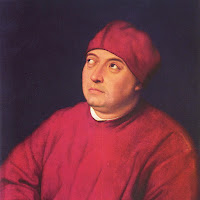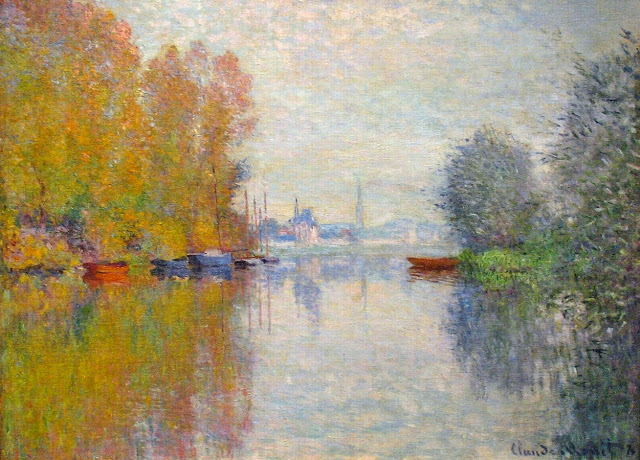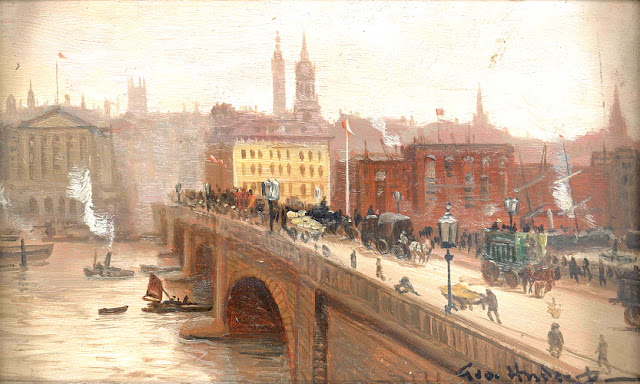The Normandy Coast
Claude Monet was the most dedicated and single-minded of the French Impressionists. He was brought up on the Normandy coast, and its beautiful scenery inspired him to devote his life to landscape painting. Fired with a desire to capture natures most fleeting effects, he painted out-of-doors in all weathers. When he moved to Paris he worked with the other great artists of his circle – Renoir, Manet and Pissarro.
Today, Monet is almost universally admired, but at first he was misunderstood and mocked. Estranged from his wealthy family, he endured misery and poverty in his early career and was in his forties before his work began to sell. By the end of Monet’s long life, he was a wealthy man and a revered artist, but success never spoiled him. Even in his 80s he still worked tirelessly, despite his failing eyesight.
Monet in his garden at about 80
The
Pioneer from Normandy
At the age of 18, Monet left a prosperous family home in Le Havre for a bohemian life in Paris. His willingness to sacrifice everything for his art had set the pattern for his career.
Claude-Oscar Monet was born in Paris on 14 November 1840, the elder son of a grocer and former sailor, Adolphe Monet. In 1845 Adolphe took over his family's flourishing grocery and ship chandlering business in Le Havre, and it was in the busy port at the mouth of the River Seine that Claude, (or Oscar, as his family called him) spent most of his happy childhood and youth.
Camille Pissarro: The Port of Le Havre 1903
His aunt, Sophie Lecadre, was an amateur painter and she no doubt encouraged the talent for drawing he showed as a boy. When he should have been attending to his lessons, Monet was often filling his books with caricatures, and by the time he was 15 such drawings had won him a local reputation and his first earnings as an artist.
Caricature of Soldiers Marching
Monet's drawings were displayed in the window of a local picture-framer's shop, a practice which led to the great turning point in his life. The landscape painter Eugène Boudin, a native of nearby Honfleur, also showed his work there, and when he met Monet he took the young man (16 years his junior) under his wing and encouraged him to paint alongside him.
Eugène Boudin: The Jetty at Honfleur, late 19th Century
Eugène Boudin: Beach Scene 1862
At that time most landscape paintings were produced in the studio, but Boudin, a specialist in sea and beach scenes, liked to paint in the open air, saying 'Everything that is painted directly and on the spot always has a force, a power, a vitality of touch that is not to be found in studio work.'
Eugène Boudin: Fisherwomen at Berk 1875
Monet at first found Boudin's paintings 'distasteful', but he was soon converted to his friend's way of thinking, and in the summer of 1858, at the age of 17, he found that landscape painting from nature was his true vocation.
Boats on the beach at Étretat 1883
'Suddenly a veil was torn away. I had understood - I had realized what painting could be. By the single example of this painter devoted to his art with such independence, my destiny as a painter opened out to me.'
Eugène Boudin: Entrance to the Port of Dieppe
The superb scenery of his Normandy home and the rapidly changing weather typical of coastal areas provided ideal material for Monet's new-found love.
Fisherman's Cottage on the Cliffs at Varengeville 1882
But Paris - the artistic capital not just of France but of the whole world - was a lure for all aspiring artists, and in 1856 Monet went there to pursue his studies, armed with letters of introduction from Boudin and his aunt.
Late 19th Century Photo of Paris
His father wanted him to study at the Ecole des Beaux-Arts, the official state school of art, but Monet was always strong-minded and self-confident, preferring to study at the Atelier Suisse.
Ecole des Beaux-Arts, Paris
Named after its founder Charles Suisse, it was an independent academy where models were provided but there were no examinations and no formal tuition. Monet's father cut off his allowance because of his disobedience.
The white corner building housed the Académie Suisse in the background.
At the Atelier Suisse, Monet met Camille Pissarro, who was to become one of the central figures of the Impressionist movement, and he frequented the Brasserie des Martyrs in Montmartre, a favourite meeting place of Gustave Courbet, Edouard Manet and other avant-garde artists.
Camille Pissarro: Two Young Peasant Women 1892
Monet's growing involvement in the cultural life of Paris was halted when he was conscripted into the army, and in 1861-62 he served in Algeria. He developed anaemia and went to convalesce at home, where his family offered to buy him out of the army if he would undertake to study with an established painter.
Portrait of Claude Monet in Uniform, 1861
Monet agreed, but before returning to Paris he met the Dutch painter Johan Barthold Jongkind, who was working at Le Havre and who with Boudin was to be the great mentor of Monet's early career.
Johan Barthold Jongkind: Moonlight on a Canal 1876
The novelist and critic Emile Zola wrote in 1868 of 'astonishing breadth' and 'masterly simplifications' of Jongkind's paintings, 'rapidly brushed for fear of losing the first impression', and in 1900 Monet said that he owed to him 'the definitive education of my eye'.
Johan Barthold Jongkind: Winter Evening on the Channel 1865
In 1862 Monet began to study at the Paris studio of Charles Gleyre, a successful painter of conventional portraits and figure compositions.
Charles Gleyre: Turkish Woman 1840
Monet was not happy following the normal academic training of painting from the nude model, but as his fellow student Pierre-Auguste Renoir remarked, if Gleyre was 'of no more help to his pupils', he at least had the merit 'of leaving them pretty much to their own devices'. Other students included Frédéric Bazille and Alfred Sisley, who with Monet and Renoir, would evolve the Impressionist style of painting. They painted together in the Forest of Fontainebleau, and Bazille, who came from a wealthy family, helped Monet financially until his death in 1870.
The Birth of Impressionism
The term Impressionism was coined in 1874 when Monet and several of his associates, including Cézanne, Degas and Renoir, held a group exhibition. A journalist called Louis Leroy made a sarcastic attack on Monet's Impression: Sunrise (below) in a review contained in the satirical magazine Le Charivari, heading his article 'Exhibition of the Impressionists'.
Monet: Impression: Sunrise 1872
The name stuck. Seven more group exhibitions followed, the last in 1886. Monet showed his work at five of the eight exhibitions.
Critics and cartoonists found the Impressionists an easy target. Their bright colours and bold brushwork made their paintings seem crude and unfinished compared with the more traditional and sober works to which the public was accustomed.
Tito Pellicciotti A fishing village on the Amalfi Coast
Gleyre was forced to close his studio in 1864 because of an eye ailment and Monet's family, dismayed at his bohemian lifestyle, again cut off his allowance. His financial problems continued to be acute throughout the 1860s and even led to a half-hearted attempt at suicide. In 1867 his mistress Camille, of whom his family disapproved, gave birth to his son, and Monet, who was staying at Sainte-Adresse near Le Havre, was so abjectly poor that he could not even raise the money to go to Paris to see them.
Monet: The Terrace 1866
Monet's father can be seen in the painting above sitting in a basket chair.
In 1870 Monet married Camille, but when war broke out between France and Prussia in the same year, he left her with his son and went to England to avoid having to fight. In London, where his family joined him later, Monet studied the work of Constable and Turner and painted some views of parks and the River Thames.
John Constable: Wivenhoe Park, Essex, 1816
Joseph Mallard William Turner: The Temple of Poseidon at Sunium (Cape Colonna) c1834
But the most important part of this escape was meeting the French picture-dealer Paul Durand-Ruel, who was the first dealer consistently to support the Impressionists.
Pierre-Auguste Renoir: Paul Durand-Ruel 1910
Although Monet would still know poverty after Durand-Ruel began buying his paintings, his life was no longer the tale of unremitting destitution it had been through so much of the 1860s.
In 1871 Monet returned to France via Holland and rented a house at Argenteuil, a village on the Seine a few miles from Paris.
Monet: The Bridge at Argenteuil 1874
When Monet moved to Argenteuil in 1871 he built a special floating studio so that he could work on the river. The painting below, executed by Edouard Manet in 1874, shows Monet on the boat with his wife Camille.
Monet's Floating Studio
By 1874 Manet came under the influence of Monet's approach to painting quickly, out of doors. In the summer of that year, Manet stayed at his family's house in Gennevilliers, just across the Seine from Monet in Argenteuil. The Monet family were living in a house that Manet had helped them find the year before.
Edouard Manet: The Monet Family in their Garden
This portrait of the Monet family - Camille Monet and Jean, with Claude Monet gardening at the left - is one of Manet's most significant essays in this new style.
Monet: Autumn on the Seine at Argenteuil 1873
This was one of the most fruitful periods in Monet's life: he was happily married and comparatively prosperous (Camille inherited some money in 1873), and the pleasures of life on the river and along its banks provided him with an abundance of subjects. His friends often visited him, and the bridges and boats of Argenteuil appear again and again in the Impressionist paintings of Renoir and Sisley.
Pierre-Auguste Renoir: Sailboats at Argenteuil 1874
Alfred Sisley: Footbridge at Argenteuil 1872
Note that the viewpoints for the three river paintings above seen from the shore are nearly the same.
At this time the Impressionists were the most united and in 1874 they held their first exhibition as a group. The show was a commercial failure, as was a group sale in the following year, and when debts began to mount, Money's idyllic Argenteuil period drew to a close. In 1878 he moved to Vétheuil, still on the Seine,
Monet: The Spring at Vétheuil 1881
but farther from Paris, and in 1879 Camille died after a long illness.
Camille Monet and her Child 1875
Monet's burden of grief and responsibility (by now he had a second son) was relieved by a women called Alice Hoschedé, the wife of a collector of Impressionist paintings, with whom he had begun an affair in 1876. She nursed Camille, looked after the children and assumed Monet's debts. Monet eventually married her in 1892 after she had become a widow.
Pauline Carolus-Duran: Portrait of Alice Hoschedé
In the next few years Monet moved to various seaside towns, including Dieppe, Pourville and Varengéville, all on the Normandy coast.
Monet: Cliff at Dieppe 1882
Monet: Low Tide at Pourville, 1882
Monet: Cliffs of Varengeville, Gust of Wind, 1882
Then in 1883 he finally settled at Giverny, about 40 miles from Paris; on the River Ept, with Madame Hoschedé; his two children and her six children. By this time the original Impressionist group had virtually broken up, and only Monet continued to pursue the Impressionist ideal - the acute scrutiny of nature.
Monet now had a settled home, but his tremendous energy led him to travel widely in search of subjects, and in the 1880s he worked extensively on the Mediterranean coast as well as in Brittany and Normandy. He also visited Holland and Italy.
Monet: Antibes in the Morning
In the same decade his reputation began to grow and his fortunes to prosper, thanks to Durand-Ruel, who in 1883 alone organised exhibitions of Impressionist paintings in Berlin, Boston, London and Rotterdam.
By 1890 Monet was secure enough financially to buy the house at Giverny he had previously rented, and in 1891 an exhibition of his paintings at Durand-Ruel's gallery in Paris sold out only three days after opening.
All the paintings at this exhibition were of haystacks, and this marked the beginning of the most original feature of Monet's later career - the production of several series of paintings in which he represented the same subject at different times of the day under different lighting conditions. Monet spent most of his time in his studio developing these series for although he still loved painting out of doors, he now realized that he could more easily obtain the effects he wanted when he had time to reflect away from the subject.
Monet: Haystacks, End of Summer, Morning
As he advanced in years, Monet continued to travel. He visited Norway in 1895 as the guest of Queen Christiana,
London three times between 1899 and 1904,
George Hyde Pownall: London Bridge
Madrid in 1904
Eugenio Lucas Villamil: Outside the Plaza de Toros, Madrid
and Venice in 1908 and 1909.
However, his attention was focused mainly on Giverny, and particularly on one part of his home - the water garden that he had developed during the 1890s on a strip of marshland next to his house. Monet had diverted a stream through it and created an exotic world of weeping willows, bamboo and floating lilies.
He began painting the garden in about 1899, and from about 1906 it became the centre of his artistic life, for in the waterlilies, with their ever-changing patterns of colour and light, he had found an inexhaustible subject: 'my pond had become enchanted'.
Enchanted Garden, Hampton Court Palace Flower Show
In 1914 Monet had a special studio built so that he could work on a huge scale. Although his wife Alice had died in 1911, he had the love of his step-daughter, Blanche Hoschede-Monet, herself a painter, to support him.
Blanche Hoschede painting Suzanne Hoschede, eldest daughter of Alice Hoschede
Monet died 5 December 1926 aged 86 at Giverny and was buried beside the small village church.
Gallery
Monet: Towing of a Boat at Monfleur 1864
Monet's work betrays a fascination with water, a popular theme in his time. But what marked Monet out from other painters was his exceptional ability to capture changing atmospheric conditions and their affects on the water he painted.
Monet: Women in the Garden 1866-7
According to the painter Gustav Courbet, Monet would not paint even the leaves in the background of this eight-foot high canvas unless the light was just right.
Monet: Lady with a Parasol 1886
This brisk and vigorous painting conveys the atmosphere of a blustery day. The rough brushstrokes of the sky suggest the scudding motion of the clouds. Monet had to work quickly to capture such fast-changing conditions in the weather.
Regatta at Argenteuil 1872
In the reflections of boat-sails on the River Seine, Monet reveals his skill at painting water. He conveys the flickering movement of the ripples with just a few brushstrokes so bold that when enlarged (see below) they seem almost abstract.
This is a prime example of the Impressionist approach to painting. In essence Monet represents what his eye actually sees, rather than what his mind knows is there. In the hands of a master, this can produce stunning vivid effects.

Monet: Field of Poppies, Argenteuil, 1873
This little painting of Monet's wife Camille and son Jean walking through a field of poppies was shown at the first Impressionist exhibition in 1874. Camille and Jean appear twice in the painting, a device which draws the eye repeatedly to the triangular hillside of bright red poppies.
Monet: Boulevard des Capucines 1873
Monet may have worked from a photograph when painting this wintry scene. On the right, a top-hatted figure looks down from a window; below, a dash of pink may represent a cluster of balloons.
Monet: The Bridge at Argenteuil 1874
Monet lived at Argenteuil, near Paris, for several years and made several paintings on the Seine. In this tranquil scene, the impression of broken reflections on the shimmering water is conveyed by well-defined brushstrokes of pure colour.
g

Monet: The Gare Saint-Lazare 1877
The railway station was the Paris terminus of the line from Argenteuil and Monet painted it several times. He captured its atmosphere - with clouds of steam and smoke rising from the engine; and shadows thrown by the glass roof - rather than a precise detailed likeness.
Monet: Rue Montargueil With Flags 1878
This birds-eye view of a Parisian avenue, decked out in celebration of the fourteenth of July, was painted rapidly on a balcony overlooking the scene. The red, white and blue stripes of the French flags form vibrant patches of colour, and in the centre of the picture a slogan in blue reads 'Vive la France'.
b

Monet: Water Lilies, Harmony in Blue 1917
Monet painted the waterlily pond at the bottom of his garden hundreds of times: it became virtually his only 'model' for the last 20 years of his life.
1840-1926
Links to more posts on painting:
Renoir

Raphael

Vermeer

Leonardo da Vinci

Boticceli

Michelangelo

Van Gogh

Pissarro

Liberty Leading the People

Claude Lorrain

Claude Monet

Caspar David Friedrich

Jacob van Ruisdael

Eugène Galien-Laloue

Èdouard Cortès















































































No comments:
Post a Comment